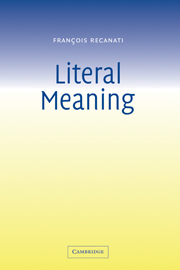Book contents
- Frontmatter
- Contents
- Acknowledgments
- Introduction
- 1 Two approaches to ‘what is said’
- 2 Primary pragmatic processes
- 3 Relevance-theoretic objections
- 4 The Syncretic View
- 5 Non-literal uses
- 6 From Literalism to Contextualism
- 7 Indexicalism and the Binding Fallacy
- 8 Circumstances of evaluation
- 9 Contextualism: how far can we go?
- Conclusion
- Bibliography
- Index
1 - Two approaches to ‘what is said’
Published online by Cambridge University Press: 08 January 2010
- Frontmatter
- Contents
- Acknowledgments
- Introduction
- 1 Two approaches to ‘what is said’
- 2 Primary pragmatic processes
- 3 Relevance-theoretic objections
- 4 The Syncretic View
- 5 Non-literal uses
- 6 From Literalism to Contextualism
- 7 Indexicalism and the Binding Fallacy
- 8 Circumstances of evaluation
- 9 Contextualism: how far can we go?
- Conclusion
- Bibliography
- Index
Summary
The basic triad
Anyone who has reflected on the sentence meaning/speaker's meaning distinction knows that a simple distinction is in fact insufficient. Two equally important distinctions must be made. First, there is the distinction between the linguistic meaning of a sentence-type, and what is said (the proposition expressed) by an utterance of the sentence. For example, the English sentence ‘I am French’ has a certain meaning which, qua meaning of a sentence-type, is not affected by changes in the context of utterance. This context-independent meaning contrasts with the context-dependent propositions which the sentence expresses with respect to particular contexts. Thus ‘I am French’, said by me, expresses the proposition that I am French; if you utter the sentence, it expresses a different proposition, even though its linguistic meaning remains the same across contexts of use.
Second, there is a no less important distinction between what is actually said and what is merely ‘conveyed’ by the utterance. My utterance of ‘I am French’ expresses the proposition that I am French, but there are contexts in which it conveys much more. Suppose that, having been asked whether I can cook, I reply: ‘I am French.’ Clearly my utterance (in this context) provides an affirmative answer to the question. The meaning of the utterance in such a case includes more than what is literally said; it also includes what the utterance ‘implicates’.
- Type
- Chapter
- Information
- Literal Meaning , pp. 5 - 22Publisher: Cambridge University PressPrint publication year: 2003



